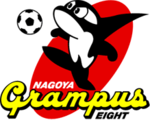Nagoya Grampus
 | |||
| Full name | Nagoya Grampus Eight | ||
|---|---|---|---|
| Nickname(s) | Grampus | ||
| Founded |
1939 (originally) 1991 (Nagoya Grampus) | ||
| Ground | Toyota Stadium | ||
| Capacity | 45,000 | ||
| Owner | Toyota | ||
| Chairman | Toyo Kato | ||
| Manager | Vacant | ||
| League | J1 League | ||
| 2016 |
J1 League, 16th (relegated) | ||
| Website | Club home page | ||
|
| |||
| Toyota Sports | ||
|---|---|---|
| |
|
|
| Football | Basketball (Men's) | Basketball (Men's) |
| |
|
|
| Basketball (Men's) | Basketball (Men's) | Basketball (Men's) |
| |
|
|
| Basketball (Women's) | Basketball (Women's) | Basketball (Women's) |
| |
|
|
| Volleyball (Men's) | Volleyball (Men's) | Baseball |
| |
|
|
| Volleyball (Women's) | Volleyball (Women's) | Sailing |
| |
|
|
| Handball | Handball | Handball |
| |
|
|
| Handball | Rugby union | Rugby union |
| |
|
|
| Wrestling | Racing | |
Nagoya Grampus (名古屋グランパス Nagoya Guranpasu) (formerly known as Nagoya Grampus Eight (名古屋グランパスエイト Nagoya Guranpasu Eito)) is a Japanese association football club that plays in the J2 League, following relegation from the J1 League in 2016. Based in Nagoya, Aichi Prefecture and founded as the company team of the Toyota Motor Corp. in 1939, the club shares its home games between Mizuho Athletic Stadium (capacity 27,000 and the J. League's oldest-serving stadium) and the much larger Toyota Stadium (capacity 45,000).
The team had its most successful season up to 1995 when it was managed by current Arsenal manager Arsène Wenger. It won the prestigious Emperor's Cup and finished second in the J. League, awith Dragan Stojković and Gary Lineker on the team. The 1995 success was eclipsed on November 20, 2010, when the club won its first J. League trophy, under the management of Stojković.[1]
The team's name was derived from the two most prominent symbols of Nagoya: the two golden grampus dolphins on the top of Nagoya Castle (which can be more accurately described as shachihoko, a mythological creature part of the local folklore), and the Maru-Hachi (Circle eight), the city's official symbol. The use of an orca in the team's logo is likely a reference to the fact that the kanji for shachihoko (鯱) can be pronounced "shachihoko" (the aforementioned mythical creature) or "shachi" (orca).
History
JSL era
Toyota Motor S.C. was overshadowed by its colleague Toyota Automated Loom Works FC (founded in 1946 and which was one of the founding members of the Japan Soccer League). When Toyota ALW were relegated to regional leagues in 1968, Toyota Motor saw an opportunity to rise at their expense.[2]
In 1972 Toyota Motors were founding members of the JSL's Second Division and its inaugural champions. They remained in the JSL until the J. League's founding in 1993. They were relegated to the JSL Division 2 in 1977. After a brief return in 1987–88, they were promoted for good in 1989–90 and remained in the top flight for 26 years, until 2016.
J. League era
In 1996, Arsene Wenger, future Arsenal manager, led Grampus to the 1996 Emperor's Cup and a runners-up finish in the J.League, the club's best finish. The team's name "Nagoya Grampus Eight" was changed to just "Nagoya Grampus" at the start of the 2008 season.[2] In 2008, Nagoya appointed former player Dragan Stojković as manager. They finished in third place and qualified for the AFC Champions League for the first time.[3] Stojković has since led the club to winning the J. League in the 2010 season, featuring a squad consisting of Marcus Tulio Tanaka, Mu Kanazaki, Seigo Narazaki, Yoshizumi Ogawa, Keiji Tamada and Joshua Kennedy.[1] After a poor 2016 season, Nagoya Grampus were relegated to J2 League for the first time in their history.[4] Boško Gjurovski left his post as manager.[5]

Episodes
Kashima Soccer Stadium curse
Since Nagoya were dealt a 5–0 defeat to the Kashima Antlers at the Kashima Soccer Stadium on 16 May in the 1993 J. League season opener, Nagoya suffered an incredible losing streak of 22 consecutive games to the Kashima Antlers at the Kashima Soccer Stadium which included Emperor's Cup and J. League Cup games. Nagoya finally got their first victory over the Kashima Antlers at the Kashima Soccer Stadium on 23 August of the 2008 J. League season, some 15 years later.
Record as J. League member
| Season | Div. | Tms. | Pos. | Attendance/G | J. League Cup | Emperor's Cup | Asia | |
|---|---|---|---|---|---|---|---|---|
| 1992 | – | – | – | – | Semi-final | 1st Round | – | – |
| 1993 | J1 | 10 | 9 | 19,858 | Group Stage | Quarter-final | – | – |
| 1994 | J1 | 12 | 11 | 21,842 | 1st Round | 2nd Round | – | – |
| 1995 | J1 | 14 | 3 | 21,463 | Runners-up | Winners | – | – |
| 1996 | J1 | 16 | 2 | 21,699 | Group Stage | 3rd Round | – | – |
| 1997 | J1 | 17 | 9 | 14,750 | Semi-final | 3rd Round | CWC | Runners-up |
| 1998 | J1 | 18 | 5 | 13,993 | Group Stage | Semi-final | – | – |
| 1999 | J1 | 16 | 4 | 14,688 | Semi-final | Winners | – | – |
| 2000 | J1 | 16 | 9 | 14,114 | Semi-final | 4th Round | – | – |
| 2001 | J1 | 16 | 5 | 16,974 | Semi-final | 3rd Round | CWC | Quarter-final |
| 2002 | J1 | 16 | 6 | 16,323 | Group Stage | 4th Round | – | – |
| 2003 | J1 | 16 | 7 | 16,768 | Semi-final | 4th Round | – | – |
| 2004 | J1 | 16 | 7 | 15,712 | Semi-final | 5th Round | – | – |
| 2005 | J1 | 18 | 14 | 13,288 | Group Stage | 5th Round | – | – |
| 2006 | J1 | 18 | 7 | 14,924 | Group Stage | 5th Round | – | – |
| 2007 | J1 | 18 | 11 | 15,585 | Group Stage | 5th Round | – | – |
| 2008 | J1 | 18 | 3 | 16,555 | Semi-final | Quarter-final | – | – |
| 2009 | J1 | 18 | 9 | 15,928 | Quarter-final | Runners-up | CL | Semi-final |
| 2010 | J1 | 18 | 1 | 19,979 | Group Stage | Quarter-final | – | |
| 2011 | J1 | 18 | 2 | 16,741 | Semi-final | Quarter-final | CL | Round of 16 |
| 2012 | J1 | 18 | 7 | 17,155 | Quarter-final | Quarter-final | CL | Round of 16 |
| 2013 | J1 | 18 | 11 | 16,135 | Group Stage | 2nd Round | – | – |
| 2014 | J1 | 18 | 10 | 16,734 | Group Stage | Quarter-final | – | – |
| 2015 | J1 | 18 | 9 | 16,240 | Quarter-final | 2nd Round | – | – |
| 2016 | J1 | 18 | 16 | 17,729 | Group Stage | 2nd Round | – | – |
- Key
- Tms. = Number of teams
- Pos. = Position in league
- Attendance/G = Average league attendance
- Source: J. League Data Site
Players
Current squad
As of November 11, 2016. Note: Flags indicate national team as defined under FIFA eligibility rules. Players may hold more than one non-FIFA nationality.
|
|
Out on loan
Note: Flags indicate national team as defined under FIFA eligibility rules. Players may hold more than one non-FIFA nationality.
|
Managers
| Manager | Nat. | Tenure |
|---|---|---|
| Ryuzo Hiraki | | 1992–93 |
| Gordon Milne | | Jan 1, 1994 – Dec 31, 1994 |
| Tetsuro Miura ‡ | | 1994 |
| Arsène Wenger | | July 1, 1995 – Sept 30, 1996 |
| José Costa ‡ | | 1996 |
| Carlos Queiroz | | Jan 1, 1997 – Dec 31, 1997 |
| Koji Tanaka | | 1997–99 |
| Daniel Sanchez | | Jan 1, 1998 – Dec 31, 1998 |
| Mazaroppi ‡ | | 1999 |
| João Carlos | | 1999–2001 |
| Tetsuro Miura | | 2001 |
| Zdenko Verdenik | | Jan 1, 2002 – Aug 4, 2003 |
| Nelsinho | | July 29, 2003 – Sept 20, 2005 |
| Hitoshi Nakata ‡ | | Sept 21, 2005 – Dec 31, 2005 |
| Sef Vergoossen | | Jan 1, 2006 – Dec 31, 2007 |
| Dragan Stojković | | Jan 22, 2008 – Dec 7, 2013 |
| Akira Nishino | | Dec 25, 2013 – Nov 22, 2015 |
| Takafumi Ogura | | Nov 24, 2015– Aug 23, 2016 |
| Boško Gjurovski ‡ | | Aug 23, 2016– Nov 6, 2016 |
‡ As caretaker manager
Honours
Toyota Motor SC (Amateur Era)
- 1968, 1970
- 1972
- Konica Cup: 1
- 1991
Nagoya Grampus (Professional Era)
- Champions (1): 2010
- Champions (2): 1996, 2011
Personnel awards
 Dragan Stojković (1995)
Dragan Stojković (1995) Seigo Narazaki (2010)
Seigo Narazaki (2010)
 Ueslei (2003)
Ueslei (2003) Joshua Kennedy (2010, 2011)
Joshua Kennedy (2010, 2011)
 Dragan Stojković (1995, 1996, 1999)
Dragan Stojković (1995, 1996, 1999) Ueslei (2003)
Ueslei (2003) Seigo Narazaki (2003, 2008, 2010, 2011)
Seigo Narazaki (2003, 2008, 2010, 2011) Marques (2004)
Marques (2004) Yoshizumi Ogawa (2008)
Yoshizumi Ogawa (2008) Joshua Kennedy (2010, 2011)
Joshua Kennedy (2010, 2011) Danilson Córdoba (2010)
Danilson Córdoba (2010) Marcus Tulio Tanaka (2010, 2011, 2012)
Marcus Tulio Tanaka (2010, 2011, 2012) Takahiro Masukawa (2010)
Takahiro Masukawa (2010) Jungo Fujimoto (2011)
Jungo Fujimoto (2011)
 Yoshizumi Ogawa (2008)
Yoshizumi Ogawa (2008)
 Arsène Wenger (1995)
Arsène Wenger (1995) Dragan Stojković (2010)
Dragan Stojković (2010)
World Cup players
The following players have been selected by their country in the World Cup, while playing for Nagoya Grampus:
 Takashi Hirano (1998)
Takashi Hirano (1998) Dragan Stojković(1998)
Dragan Stojković(1998) Seigo Narazaki (2002, 2006, 2010)
Seigo Narazaki (2002, 2006, 2010) Keiji Tamada (2006, 2010)
Keiji Tamada (2006, 2010) Joshua Kennedy (2010)
Joshua Kennedy (2010) Marcus Tulio Tanaka (2010)
Marcus Tulio Tanaka (2010)
League history
- Tōkai Football League: 1966–71
- Division 2 (JSL Div. 2): 1972
- Division 1 (JSL Div. 1): 1973–77
- Division 2 (JSL Div. 2): 1978–86
- Division 1 (JSL Div. 1): 1987
- Division 2 (JSL Div. 2): 1988–89
- Division 1 (JSL Div. 1): 1990–91
- Division 1 (J. League Div. 1): 1992–2016
- Division 2 (J2 League): 2017–
(As of 2015): 33 seasons in the top tier, 12 seasons in the second tier and 6 seasons in the Regional Leagues.
See also
- Grampus-kun (The team mascot)
References
- 1 2 John Duerden (2010-11-05). "Stojkovic doing things the Wenger way". ESPNsoccernet. Retrieved 2010-11-20.
- 1 2 "Club guide: Nagoya Grampus". J. League. Retrieved 20 January 2015.
- ↑ "J. League News No.40" (PDF). J. League. December 19, 2008. Retrieved 10 January 2015.
- ↑ "名古屋グランパスを支えていただいてる皆さまへ(来シーズンのJ2降格を受けて". nagoya-grampus.jp (in Japanese). Nagoya Grampus. 4 November 2016. Retrieved 7 November 2016.
- ↑ "ボスコ・ジュロヴスキー監督、契約満了のお知らせ". nagoya-grampus.jp (in Japanese). Nagoya Grampus. 6 November 2016. Retrieved 7 November 2016.
External links
| Wikimedia Commons has media related to Nagoya Grampus. |